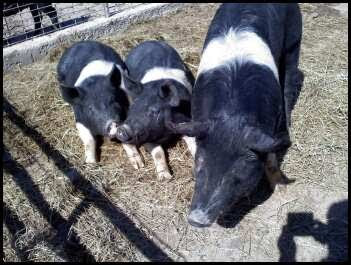A day starts at 8am. Not bad for a farm-I've dealt with earlier. Also, my commute is a 5-minute walk across a ranch full of animals as the sun rises in front of me. We'll soon start at 7am when the goats need to be milked. We're enjoying the winter quiet now.
We split up and pile into our two farm trucks, one group doling out grain and one group dropping hay. We visit the camels, llamas, water buffalo and bulls first, usually.

 Camels, llamas and water buffalo are exhibition animals, kept to educate rather than for productive reasons. The bulls are breeding stock.
Camels, llamas and water buffalo are exhibition animals, kept to educate rather than for productive reasons. The bulls are breeding stock.
Then on to the pigs. We have 11 pigs of different ages. Gloria, the one standing, is the oldest. We have four piglets that get bigger every day. They'll all get huge soon. Then we eat them. Until then, it's fun to play with them, and throw them a flake of hay, which they tear up, squealing. It's their favorite thing.
We have 11 pigs of different ages. Gloria, the one standing, is the oldest. We have four piglets that get bigger every day. They'll all get huge soon. Then we eat them. Until then, it's fun to play with them, and throw them a flake of hay, which they tear up, squealing. It's their favorite thing.
And the rams and bucks, kept for breeding.
The goats are everyone's favorite. There are meat goats and dairy goats. They have such personalities, and will do almost anything for food. They can open certain types of latches on gates, and enjoy running around the farm when they get out. They'll descend on an area and strip it like locusts. They're pretty clever and very strong. I want to get a goat cart, but I can't get anyone to sign on to the idea...
There are meat goats and dairy goats. They have such personalities, and will do almost anything for food. They can open certain types of latches on gates, and enjoy running around the farm when they get out. They'll descend on an area and strip it like locusts. They're pretty clever and very strong. I want to get a goat cart, but I can't get anyone to sign on to the idea...
We eventually check the cattle, which are split into a group of fat ones and a group of skinny ones.
Somewhere in there we check on the horses and the donkeys, who are exhibition animals only (they have quite a life--no need to work).
We have 4 Belgian draft horses, who can all drive and are all trained to be working horses. We have two giant donkeys, who are large enough to be ridden. We'll probably be downsizing our herd soon.
Back in the Show Barn, where field trips of school children are taken to learn about all of our animals, we check on the rabbits and turkeys, and collect the eggs from the chickens and ducks.
Eventually we head on down to the Bottoms, the flood plain by the river where our huge pastures are. That's where the sheep are until lambing. We feed their three guard dogs, who keep the coyotes away (but sadly can't herd) and check the flock for limpers, stragglers or other sheep needing attention.
After morning chores, we all head to the projects we've scheduled, which we'll do all day, with a break for lunch, until evening chores. Until babies come, everything is sane, with a nice routine.
Saturday, February 13, 2010
When Daily Life Is An Adventure: Daily Chores
Subscribe to:
Post Comments (Atom)

No comments:
Post a Comment